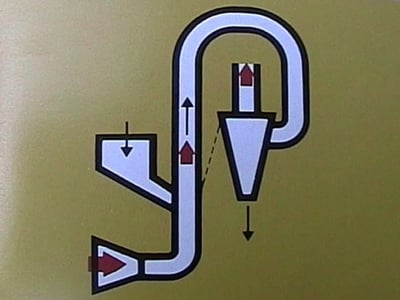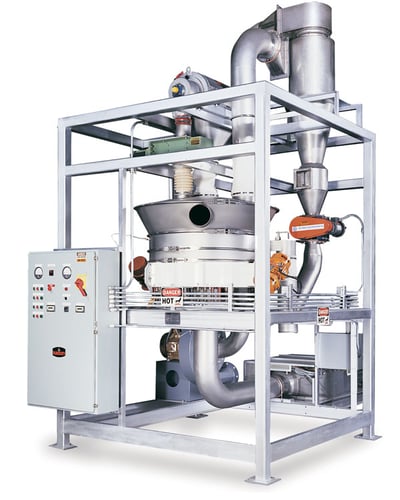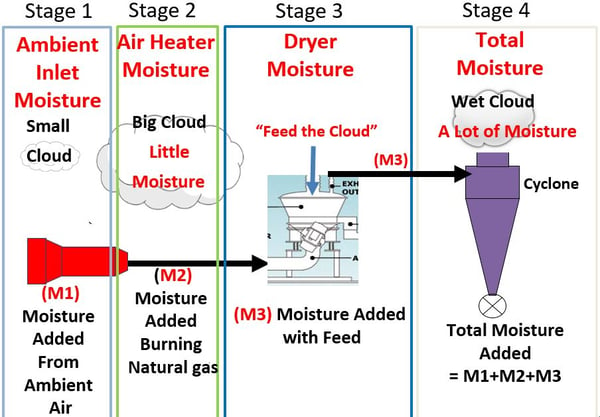There are two major types of dryers: Direct and Indirect Dryers. Direct Dryers utilize hot air as the mechanism of water evaporation while Indirect Dryers utilize rotating heated surfaces to transmit heat into the wet product.
The most common dryers are Direct Dryers that use natural gas to heat the drying air. It is important to keep in mind that there’s no one-size-fits-all dryer option that’s used for every application. In this article, we will concentrate on different Direct Dryers that can dry a wet solid feed material.
Dryer Design: Analyzing the “Weather” Within and Outside of the Dryer
In order to understand the direct drying process, you need to assume the role of a fluid bed “meteorologist,” modeling what the air/moisture properties are at any point in the process. The diagram below shows the four stages of a direct dryer system:
Each stage shows a formation of a cloud, with the shaded areas representing the relative amount of water vapor, and how the cloud expands and absorbs water vapor during each of the four stages. This can be modeled on a psychrometric chart.
Stage One shows the inlet with the ambient moisture (# of water vapor/# of dry air) coming into the dryer. The size and the amount of water vapor of the cloud is small.
In Stage Two, the air is heated to the inlet air temperature. The higher the amount of heated air from the natural gas air heater, the more the air expands and allows the air to carry away more water vapor. In a way, this serves to strengthen the hot air stream and enable it to take away more water vapor. Depending on the inlet air temperature, the air may double the specific volume of air. Some additional water vapor is added to the cloud by burning natural gas.
At Stage Three, the screw feeder dumps product with water into the dryer and “feeds” the cloud.
In the fourth stage, the moist air is expelled from the machine as the cloud cools and contracts while still retaining the water vapor from the prior stages. The relative percentage of moisture in the outlet air can be measured by its relative humidity (percentage of actual vapor pressure/saturated vapor pressure) or the Adiabatic Saturation Ratio (or ASR – percentage of actual weight of water vapor/weight of saturated water vapor). Relative Humidity is used more with HVAC systems and is not as functional at much higher air temperatures. On a psychrometric chart, the ASR is mathematically split into ten equal percentages. At 60 percent ASR, we know that you can add 40 percent more water vapor to reach saturation. The ASR cannot be more than 100 percent. Depending on the temperature profile, an acceptable ASR is in the 70-90 percent range in most direct dryers and still be able to attain the final product moisture.
The challenge of a direct dryer is maximizing the time the wet feed is in contact with the heated drying air. When specifying drying equipment, you'll want to address a checklist of major factors that will affect drying rates, efficiencies, and features need in the direct drying system you choose.
These factors can include:
- Direct Dryer Methodology: Conveyor, Flash, Fluid Bed, Rotary
- Airflow rate
- Airflow direction
- Moisture content of materials and air
- Moisture removal flow and rate
- Temperature of materials and air
- Heat sensitivity
- Particle range, size, color, taste & shape
- Layout
- Sanitary considerations
- Capital and operational cost
- Maintenance
- Installation cost
Drying Curve
 The drying curve for material shows the reduction in moisture over time as the material is processed. Flash dryers give a very fast reduction in moisture, but they aren’t always effective in getting to the lowest moisture content in materials.
The drying curve for material shows the reduction in moisture over time as the material is processed. Flash dryers give a very fast reduction in moisture, but they aren’t always effective in getting to the lowest moisture content in materials.
Reaching lower product moisture levels requires a longer exposure time to allow moisture to migrate from the center of the particle. For that reason, dryers with a longer residence time such as the rotary, conveyor and fluid bed dryers will give a more consistent and low-moisture content result. It is not uncommon to go to a two-stage dryer to take advantage of the short heat exposure of a flash dryer, followed by a longer-exposure, more efficient secondary dryer.
Temperature Variation and Testing
Ultimately, the only way to know exactly how a dryer will perform with a particular material is to perform testing. Typically, manufacturers will have a small laboratory test dryer where it’s possible to run small batches at different drying times and temperatures. After running tests in small dryers, the scaling-up calculation takes into account the retention time (volume of the bed/the flow rate) to figure out the heat and mass balance needed for scaling to a larger dryer.Heat loss of each dryer is individual, depending on the size and insulation of the dryer. Smaller dryers have a higher range of heat loss due to larger surface areas versus airflow, amounting to up to 20 percent more heat lost when compared to larger dryers. One of the advantages of relatively short retention direct dryers is the evaporative cooling effect as the feed material dries. For that reason, the “rule of thumb” of the inlet air temperature can be as much as 50° Celsius above the sticking point or degradation point of the material. The outlet air temperature (the temperature of the vented air after drying) is important in controlling the product moisture. Some dryer operators actually control the wet-bulb or the dew point temperature to control product moisture. The temperature and water vapor loading of the outlet air stream will relate to the final product moisture.
Comparing Different Direct Dryers
Rotary Dryers
 Rotary Dryers are Direct Dryers designed with rotating, “tumbling” drums and internal lifters to “rain” the moist solid through the passing heated drying air. The challenge of this dryer is maximizing the time the wet feed is exposed to the heated drying air. The better the contact, the shorter the rotary dryer’s length and cost. The final design will depend on the retention time required.
Rotary Dryers are Direct Dryers designed with rotating, “tumbling” drums and internal lifters to “rain” the moist solid through the passing heated drying air. The challenge of this dryer is maximizing the time the wet feed is exposed to the heated drying air. The better the contact, the shorter the rotary dryer’s length and cost. The final design will depend on the retention time required.Advantages:
- High tonnage capability
- Lower costs if stainless steel not required
- If you can use very high temperatures then the amount of air can be reduced, improving dryer efficiency
- Lifters can be used to maximize product/heated air contact
- In some applications, counter-current flow design can be more effective
- Difficult to clean
- Wet feed is only in contact with the heated air for a short time
- Large plot space required
- At lower temperatures more airflow is needed, making it less efficient
- Rotary elements could pose maintenance problems
- Not as efficient when dealing with heat-sensitive materials
- Minerals
- Wood chips
- Limestone
- Ceramics
- Fertilizers
- Potash
- Spent Grains
- Sulfates
Conveyor/Belt Dryer
 Conveyor dryers (also called belt, tunnel or apron dryers) are rotating belt conveyors typically equipped with a perforated belt to allow heated air to circulate through the belt and the wet feed. The challenge for this dryer is getting the heated air into contact with the inner layer of the feed on the belt. Some use multiple belts to reorient the feed and expose internal surfaces to the heated air.
Conveyor dryers (also called belt, tunnel or apron dryers) are rotating belt conveyors typically equipped with a perforated belt to allow heated air to circulate through the belt and the wet feed. The challenge for this dryer is getting the heated air into contact with the inner layer of the feed on the belt. Some use multiple belts to reorient the feed and expose internal surfaces to the heated air.Advantages:
- Minimal product attrition
- Can handle a wide range of particle sizes
- Able to process sugary and sticky products
- Large plot space required
- Difficult to get uniform moisture due to inconsistent belt loading
- Potential for cross-contamination
- Fine powders can build up on housing
- Difficult to protect against explosive products
- Special feed devices required to spread the feed material evenly and expose surfaces
- Sweetened Cereals
- Fruits and Vegetables
- Pet Foods
- Agglomerates
- Potato Products
- Extruded Snacks
Flash Dryers
 A Flash Dryer is a hot pneumatic conveyor. The challenge is to increase the exposure time from a few seconds. There are variations such as recycling large particles, or inline particle size reduction to aid in drying.
A Flash Dryer is a hot pneumatic conveyor. The challenge is to increase the exposure time from a few seconds. There are variations such as recycling large particles, or inline particle size reduction to aid in drying.Advantages:
- Can handle fine powders
- Many manufacturers can build their own
- Able to handle some heat-sensitive materials due to its short retention time
- Built-in air conveying
- Difficult to handle heavy powder
- May require back-mixing of wet feed with dried recycled powders
- Will break up agglomerates
- Uses a large amount of air, making it less efficient
- Not good for abrasive materials
- Starches
- Fine Chemicals
- Fibers
- Plastic Pellets
- Dyes
- Pigments
Fluid Bed Dryers
 Fluid Bed Dryers use heated air to fluidize and dry feed material and are either static or vibrating in design. Static fluid beds can have bed depths that minimize the size of the dryer and the amount of drying air required. The inefficiency of a Direct Dryer is the exhausted hot air; minimizing the amount of air increases the dryer's efficiency.
Fluid Bed Dryers use heated air to fluidize and dry feed material and are either static or vibrating in design. Static fluid beds can have bed depths that minimize the size of the dryer and the amount of drying air required. The inefficiency of a Direct Dryer is the exhausted hot air; minimizing the amount of air increases the dryer's efficiency.- Heated air is in contact with the product at all times
- Can handle a wide range of products
- Multiple stages allow for stepped treatment of heat-sensitive materials
- Gentle handling of fragile products
- Circular vibrating units are capable of internal back-mixing of pasty feed materials
- Easy scale-up via product retention time
- Feed products must be friable and able to fluidize
- Vibration needs to be isolate
- Low temperatures increase the need for more airflow
- Nuts and Seeds
- Bread Crumbs
- Wood Flour
- Agchem
- Fertilizers
- Catalysts
- Agglomerates
- Ceramic Beads
- PVC Powder
Shape: Circular or Rectangular Fluid Bed Dryers
The shape of a fluid bed dryer can have a significant impact on its airflow, effectiveness, and its ability to be cleaned. Rectangular fluid bed dryers can be built to higher capacities and with multiple stages. Rectangular dryers, however, tend to have “dead” areas in their corners. This issue is eliminated in circular fluid bed dryers, as there are no corners where materials can get stuck. Product clumping is prevented while a more uniform airflow is promoted throughout the bed, accelerating the drying process.- Continuous internal back-mixing for drying more sluggish or
hard to fluidize materials - Smaller footprint per volume processed due to deeper bed depth
- Simple installation and portability
- Lower installation and operational costs
- Reduced power consumption
- Relatively low noise
- Minimized explosion protection requirements due to higher pressure circular design
The design of industrial Direct Dryers takes into account a multitude of factors, and it's important to keep in mind that no singular dryer is a perfect fit for all applications. Learning about different dryer capabilities is critical when searching for the right equipment for your specific drying application. Familiarize yourself with the types of dryers available, and be sure to analyze the “weather” at any point of the four stages of drying to get the best understanding of a Direct Dryer. The temperature profile, retention time, airflow and moisture reduction capacity are all major factors influencing the dryer design, but there are a number of customizations that can also contribute to the appropriateness of a particular dryer for a specific application. It is also vital that you undergo testing before getting an estimate - something that most manufacturers are happy to accommodate as they assist you in your dryer evaluation process.


